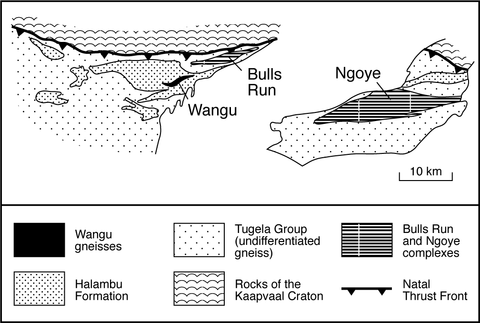stripes
On Wangu Hill, about 18 km northwest of Eshowe, a group of peralkaline gneisses forms a 6 km-long body which is up to 1 km wide. They lie within granodioritic gneisses of the Halambu Formation with contacts that are probably tectonic, possibly thrusts. There is a prominent east-west planar foliation parallel to the length of the body. The gneisses are generally aplitic in appearance but there are some elongate zones up to 20 m long and 10 cm wide of relatively mafic magnetite- and pyroxene-rich gneisses. The gneisses have the assemblage quartz, microcline, albite, aegirine-augite, riebeckite, biotite and magnetite. Some biotite-rich gneisses that form sheet-like bodies on the southern part of the outcrop are believed by Scogings (1989) to have intruded the peralkaline gneisses of which they contain abundant xenoliths. Numerous modal and chemical data, with a full range of trace elements including rare earths, are available indicating the peralkalinity and relative enrichment in Zn, Nb, Zr, Y and REE and the similarity to many peralkaline granites.
SCOGINGS, A.J. 1989. Peralkaline granitoid and associated alkaline mafic gneisses northwest of Eshowe, Natal. South African Journal of Geology, 92: 339-51.

